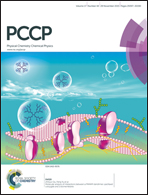A computational study of the self-assembly of the RFFFR peptide
Abstract
The β-amyloid peptide sequence, LVFFA, inspired the investigation of the fiber formation potential of the RFFFR peptide. The self-assembly was studied in silico by coarse grained-, atomistic molecular dynamics simulations and semi-empirical quantum mechanical calculations. The fiber formation was found to occur according to a three step process starting with the emergence of small aggregates that join together and form fiber segments that eventually form one continuous fiber. From a series of simulations the critical fiber concentration was determined to be in the interval between 70 mM and 100 mM. To obtain more structural information of the stable fiber, the final coarse grained configuration was backtransformed to atomistic detail. Based on this structure a 10 ns atomistic simulation was performed, which suggests that the fiber is stabilized by hydrogen bonds and water mediated hydrogen bonds. These stabilizing bonds are, however, reduced by competitive protein–water hydrogen bonds. Hence, π-stacking is suspected to play a larger role in fiber stabilization. The π-stacking of intermolecular Phe residues are found to favor a T-shaped stacking mode, while intramolecular π-stacking interactions assume a broad variety of modes from the parallel displaced mode to the T-shaped stacking mode and modes in between, with equal probability. Selected snapshots from the atomistic simulation were geometry optimized using semi-empirical quantum mechanical methods to validate the fiber stability and π-stacking configuration. An average Cα-RMSD was determined to be 2.68 Å. These findings indicate that the fiber may be used as a novel model system for the study of amyloid fibers or self-assembled conductive biowires, respectively.


 Please wait while we load your content...
Please wait while we load your content...